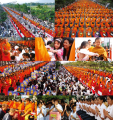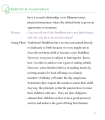traditional clothing : ค้นหาหนังสือธรรมะ หน้า 2 / 8
หน้าหนังสือทั้งหมด

186
Understanding the Five Precepts and Spiritual Cultivation
Part Seven: Appendixes
All of these precepts are meant to decrease kilesa,
especially sexual desire and allow us to focus on spiritual
cultivation.
Five Precepts: five rules of conduct that we can cho
This section discusses the Five Precepts aimed at reducing kilesa, particularly sexual desire, fostering spiritual growth. The Five Precepts include refraining from killing, stealing, sexual misconduc

177
Understanding Austerity and Mindfulness in Buddhist Practice
observing the eight precepts, and meditating. Those who wish
to practice must stay at a temple. Accommodations can depend
on the geographical conditions where the temples are located
and their ability
บทเรียนเรื่องการอุทิศตนให้อื่นได้รับการอธิบายโดยพระอาจารย์ซึ่งชี้ให้เห็นว่าวิธีการปฏิบัติอาจช่วยให้เราเข้าใจความต้องการและความปรารถนา ตัวอย่างเช่น ผู้คนมักแยกแยะความต้องการและความปรารถนาออกจากกันไม่ถู

34
Understanding Basic Needs and Their Impact on Character Development
Suzanne Jeffrey
But the four basic needs are the first four that I mentioned: food, shelter, clothing, and medicine. Who, then, provides us with these needs? Usually, our parents or guardians are the
The text discusses basic human needs such as food, shelter, clothing, and medicine, emphasizing the role parents or guardians play in fulfilling these needs. It explains the consequences of receiving

95
Exploring Spiritual Imagery and Meditation
1. (Images of Buddha, meditation, natural scenes, and traditional textiles)
2. (Images of women interacting, people at a temple, and group discussions)
3. (Black and white images of planets or moons,
This content presents a compilation of images symbolizing spirituality and meditation, encompassing depictions of the Buddha, natural settings, and traditional textiles. It features women engaging in

35
Study of Buddhist Texts and Sectarian Developments
HONJŌ, Yoshifumi (本庄良文).
1992 “Saurātantika.” Indogaku-Bukkyōgaku-kenkyū 印度学仏教学研究 40(2): 148-154(L).
NATIER, Janice J., Charles S. PREBISH.
1977 “Mahāsāṃghika Origins: The Beginnings of Buddhist Sect
This compilation includes vital research contributions on Buddhist sectarian origins and the study of specific texts. Notable works such as Yoshifumi Honjō's study on Saurātantika and Janice Natier's

129
Sustainable Community Development and Collaboration
CONTRIBUTORS
255
mentee applications
wonders Tools
website Tips
Pro Bono Tionring
Pro bono Tansport
Pro Bono Taked Testing
Pro Bono Support
Pro Bono Support Tansport
Pro Bono Support Transport & Adva
This text highlights the importance of sustainable development in local communities, focusing on ethical collaborations and the preservation of traditional art skills. By learning and integrating loca

69
Success of Moral Training Projects: Dhammadayada Program
ASE HISTORY OF THE SUCCESS OF MORAL TRAINING PROJECTS
The Dnammadayada (Dhamma Inheritors) Training Programme has been conducted for twenty-seven years since the beginning of the Dhammikaya Foundatio
The Dhammadayada Training Programme has operated for twenty-seven years, focusing on hands-on Buddhist practice for students. In 1996, the program was scientifically assessed, revealing that participa

138
Exploring Chinese Philosophical Texts and Their Influence
Kohn, Livia, and Yoshinobu Sakade. Taoist Meditation and Longevity Techniques. Center for Chinese Studies, University of Michigan, 1989.
Mair, Victor H. “What Is Geyi, After All?” In Philosophy and Re
This collection examines various texts that shed light on the development of Chinese philosophical thought and literary traditions. Works range from Livia Kohn's exploration of Taoist meditation pract

121
The Influence of An Shigao on Mindfulness Breathing Meditation in Eastern Han China
In this paper I explore the connections between An Shigao and the introduction of the Indian Buddhist meditation technique of mindfulness breathing meditation, or ānāpānasmṛti, into Eastern Han China.
This paper examines An Shigao's role in introducing the Indian mindfulness breathing meditation technique, ānāpānasmṛti, into Eastern Han China. The phrase「息中具有四大。 而心在中」suggests that the mind should f

83
Understanding Dhammakāya in Theravāda Buddhism
In a few passages, however, Sāriputta also refers to the term dhammakāya in the sense of the Buddha’s teaching.150
On the whole, traditional Theravādins interpret the term dhammakāya mostly in the se
This passage examines the term 'dhammakāya' as interpreted in traditional Theravāda Buddhism. It discusses the general view of dhammakāya as reflecting the qualities of the Buddha and the spiritual re

72
Understanding the Levels of Dhammakāya and Noble Disciples
In regard to the different levels of dhammakāya, the canon talks about the different states of trainees (sekha) and non-trainees (asekha). The former refers to states in which a further course is yet
The text elaborates on the different levels of dhammakāya, categorizing trainees and non-trainees based on their qualities and practices. Trainees are seen as individuals who still have further course

40
Understanding Dhammakāya in Aṅgāṇā-sutta
In brief, contemporary academics refer to the term dhammakāya in the Aṅgāṇā-sutta either as a noun or an adjective. As a noun, the term is interpreted mostly as the Buddha’s teachings collected togeth
The term dhammakāya is interpreted in contemporary academia as both a noun and an adjective. As a noun, it denotes the Buddha’s teachings, while as an adjective, it refers to the nature of the Tathāga

33
Reinterpreting Dhammarāya in the Pali Canon
Most of them refer only to the Aggañña-sutta passage, 4 missing out the three Apadāna references. 5 The reason could be either that the scholars concerned have taken the aforementioned text as represe
This paper examines the overlooked references to dhammarāya in the Pali canon, emphasizing a context not previously presented. It critiques the tendency to categorize texts strictly as ‘early Buddhism

18
Understanding Dhammakāya and Theravāda Manuscripts
and is ‘spiritually reborn’. The dhammakāya becomes her new identity as the milk nourishes her spiritually. It is something she is given as a verbal teaching.
To add the material from the Apadānas is
This text delves into the doctrine of dhammakāya, representing a new spiritual identity that arises from teachings, akin to nourishment from milk. It connects the concepts found in the Agañña-sutta, i

62
Large Buddhist Event Participation
The image contains multiple photographs of a large Buddhist event, showing thousands of monks, nuns, and laypeople participating in religious activities, including prayer, almsgiving, and procession.
This image captures a large Buddhist event attended by thousands, showcasing the devotion of monks, nuns, and laypeople. Participants, dressed in vibrant orange robes and traditional attire, engage in

38
Five Responsibilities of a Husband and Wife in Marriage
Five Responsibilities of a Husband to His Wife
1.1 Appreciation. The husband should openly respect her as his lawful wedded wife, not furtively keeping her like a mistress. If his wife does something
In a traditional marriage, husbands have key responsibilities to appreciate, consult, and support their wives while maintaining faithfulness. Wives, on the other hand, are expected to manage the house

16
Spiritual Gathering Event
The image shows a large gathering of people, all seated with hands pressed together in a prayer or meditation gesture. In the foreground, there is a prominent figure, an elderly man dressed in traditi
The image captures a significant spiritual gathering where an elderly man in traditional white robes presides over a large assembly of individuals. With a microphone in front of him, he guides the aud

79
Understanding Family Challenges in Children's Education
Part Three: Problems Within the Family
When it comes to children's education, most parents
are supportive, but some have too high of an expectation.
For the sake of your children, do not be one of tho
This section emphasizes the need for parents to recognize their children's unique talents that may not align with traditional academic success, advocating against imposing high expectations tied to pe

37
Family Life Principles
Part One: Family Life
1. Giving (dana): Loving and living together requires
sharing. Where there is no giving, the atmosphere
feels very unpleasant. Sharing encompasses sharing
of problems, too. When
This text discusses four fundamental principles for enhancing family life: 1. Giving (dana) emphasizes the importance of sharing, including sharing problems to foster support. 2. Polite speech (piyava

17
Buddhist Perspectives on Birth Rituals and Rebirth
Rebirth & Incarnation
Monica
have a sexual relationship, or in Dhamma terms,
physical intercourse where the refined body is given an
opportunity to incarnate.
: Can you tell me if the Buddhists have a
In Buddhism, traditional practices do not involve specific rites for birth as the belief holds that one should not impose the Buddhist faith on newborns. Instead, the focus is on educating children to
